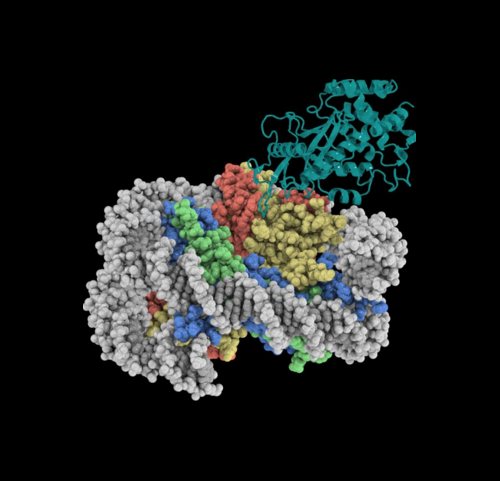|
|
Developmental Biology - The cGAS Protein
Why Your Immune System Does Not Attack You
Inside our cells, the protein cGAS blocks our body from triggering our own immune system take down...
Qi Zhang PhD and Robert McGinty MD PhD, both with the University of North Carolina (UNC) Eshelman School of Pharmacy, used cryo-electron microscopy to capture the first-ever image of cGAS protein bound to DNA inside cell nuclei. The binding of cGAS to DNA, safeguards key DNA sensors from attacking our immune system.
The research is published in Science, revealing details of how nucleosomes inside our cells block cGAS from unintentionally triggering an innate immune response to our own DNA.
"Detecting and responding to foreign DNA from bacterial and viral pathogens is one of the most fundamental mechanisms for host defense. A deeper understanding of function and regulation of this important DNA sensor, will have profound impacts on both basic research and development of cGAS-targeted therapeutics."
Qi Zhang PhD, Associate Professor, Biochemistry and Biophysics, UNC Eshelman School of Pharmacy and co-senior author.
"This work was enabled by recent advances in cryo-electron microscopy technology that allows scientists to observe protein machines inside our cells with unprecedented clarity. Seeing how proteins function, we gain insights to manipulate their function and treat diseases," explains Robert McGinty MD PhD, Assistant Professor of Chemical Biology and Medicinal Chemistry at UNC Eshelman School of Pharmacy, and co-senior author of the research.
In a mammal's immune system, the protein cyclic GMP-AMP synthase (cGAS) detects foreign or damaged DNA — activating cGAS-STING signals to fight infection, inflammatory diseases and cancers.
As cGAS is a "universal" DNA sensor, it is able to differentiate between pathogenic DNA as unique from our body's own healthy DNA — avoiding unintentional immune activation within us.
Previous research showed that cGAS is enriched inside the nucleus where our genomic DNA is stored. But it was a mystery how cGAS ignores our own healthy DNA.
Using the UNC School of Medicine state-of-the-art Cryo-Electron Microscopy Core Facility, just established in 2019, the Zhang and McGinty labs now saw how a 3.3Å-resolution cryo-EM structure of cGAS reacted in complex with the nucleosome [a section of DNA wrapped around a core of proteins].
The cGAS structure showed how cGAS uses two amino acids to anchor to a negatively charged patch on the nucleosome surface. This protein on protein interaction allowed the nucleosome to occupy a critical DNA sensing surface on cGAS and prevent cGAS from entering into a functionally active DNA-bound state.
Along with mutagenesis and functional assays, this study provided a near-atomic resolution depiction of cGAS maintaining a resting, inhibited state within the nucleus.
"These findings reshape the current paradigm of cGAS regulation and exemplify the role of the nucleosome in regulating diverse protein functions," explains McGinty, who holds a joint faculty appointment with the UNC School of Medicine.
Zhang adds, "Biomedical scientists will be able to apply our research to fields such as immunology, cancer biology, and gene regulation, as well as to drug discovery for infections, inflammatory diseases, and cancers."
Their paper published online in the journal Science, September 10, 2020.
Abstract
In the mammalian innate immune system, the protein cyclic GMP-AMP synthase (cGAS) detects foreign or damaged "self" DNAs. Upon DNA detection, cGAS synthesizes cyclic GMP-AMP (cGAMP), the second messenger molecule that activates the cGAS-STING signaling pathway to fight infections, inflammatory diseases, and cancers. Because cGAS is a "universal" DNA sensor, it must be regulated to differentiate pathogenic DNA from the body's own healthy DNA to avoid any unintended immune responses. Previous research has shown that cGAS is enriched inside the nucleus where our genomic DNA is stored, but it remains a mystery as how cGAS ignores our own healthy DNA. Using the UNC School of Medicine state-of-the-art Cryo-Electron Microscopy Core Facility, which was established in 2019, the Zhang and McGinty labs determined a 3.3Å-resolution cryo-EM structure of cGAS in complex with the nucleosome. The structure shows that cGAS employs two conserved amino acids to anchor to a negatively charged patch on the nucleosome surface. These protein-protein interactions allow the nucleosome to occupy a critical DNA sensing surface on cGAS and prevent cGAS from entering its functionally active DNA-bound state. Together with mutagenesis and functional assays, this study provides a near-atomic resolution depiction of how cGAS maintains the resting, inhibited state in the nucleus.
Authors
Joshua A. Boyer, Cathy J. Spangler, Joshua D. Strauss, Andrew P. Cesmat, Pengda Liu, Robert K. Mcginty, Qi Zhan.
Acknowledgements
Funding for this research was provided through grants from the National Institutes of Health, a UNC School of Medicine Jefferson Pilot Fellowship to Qi Zhang, and Searle Scholars and Pew-Stewart Scholars awards to Robert McGinty. The Cryo-Electron Microscopy Facility, which is partially supported by the NIH, is part of the Molecular Microscopy Consortium of the University of North Carolina at Chapel Hill, Duke University, and the National Institute of Environmental Health Sciences.
Return to top of page.
| |
|
Sep 15, 2020 Fetal Timeline Maternal Timeline News
 The very first high resolution image of the protein cGAS (TEAL) bound to the nucleosome — DNA packaged to fit inside the nucleus of a human cell. CREDIT UNC Chapel Hill, North Carolina USA.
|



